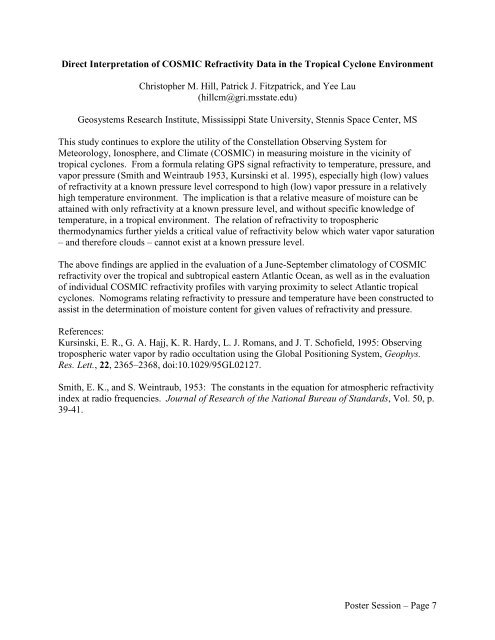65th IHC Booklet/Program (pdf - 4.9MB) - Office of the Federal ...
65th IHC Booklet/Program (pdf - 4.9MB) - Office of the Federal ...
65th IHC Booklet/Program (pdf - 4.9MB) - Office of the Federal ...
Create successful ePaper yourself
Turn your PDF publications into a flip-book with our unique Google optimized e-Paper software.
Direct Interpretation <strong>of</strong> COSMIC Refractivity Data in <strong>the</strong> Tropical Cyclone Environment<br />
Christopher M. Hill, Patrick J. Fitzpatrick, and Yee Lau<br />
(hillcm@gri.msstate.edu)<br />
Geosystems Research Institute, Mississippi State University, Stennis Space Center, MS<br />
This study continues to explore <strong>the</strong> utility <strong>of</strong> <strong>the</strong> Constellation Observing System for<br />
Meteorology, Ionosphere, and Climate (COSMIC) in measuring moisture in <strong>the</strong> vicinity <strong>of</strong><br />
tropical cyclones. From a formula relating GPS signal refractivity to temperature, pressure, and<br />
vapor pressure (Smith and Weintraub 1953, Kursinski et al. 1995), especially high (low) values<br />
<strong>of</strong> refractivity at a known pressure level correspond to high (low) vapor pressure in a relatively<br />
high temperature environment. The implication is that a relative measure <strong>of</strong> moisture can be<br />
attained with only refractivity at a known pressure level, and without specific knowledge <strong>of</strong><br />
temperature, in a tropical environment. The relation <strong>of</strong> refractivity to tropospheric<br />
<strong>the</strong>rmodynamics fur<strong>the</strong>r yields a critical value <strong>of</strong> refractivity below which water vapor saturation<br />
– and <strong>the</strong>refore clouds – cannot exist at a known pressure level.<br />
The above findings are applied in <strong>the</strong> evaluation <strong>of</strong> a June-September climatology <strong>of</strong> COSMIC<br />
refractivity over <strong>the</strong> tropical and subtropical eastern Atlantic Ocean, as well as in <strong>the</strong> evaluation<br />
<strong>of</strong> individual COSMIC refractivity pr<strong>of</strong>iles with varying proximity to select Atlantic tropical<br />
cyclones. Nomograms relating refractivity to pressure and temperature have been constructed to<br />
assist in <strong>the</strong> determination <strong>of</strong> moisture content for given values <strong>of</strong> refractivity and pressure.<br />
References:<br />
Kursinski, E. R., G. A. Hajj, K. R. Hardy, L. J. Romans, and J. T. Sch<strong>of</strong>ield, 1995: Observing<br />
tropospheric water vapor by radio occultation using <strong>the</strong> Global Positioning System, Geophys.<br />
Res. Lett., 22, 2365–2368, doi:10.1029/95GL02127.<br />
Smith, E. K., and S. Weintraub, 1953: The constants in <strong>the</strong> equation for atmospheric refractivity<br />
index at radio frequencies. Journal <strong>of</strong> Research <strong>of</strong> <strong>the</strong> National Bureau <strong>of</strong> Standards, Vol. 50, p.<br />
39-41.<br />
Poster Session – Page 7
















